Port Macquarie Australian Day Event: A Case Study Report
VerifiedAdded on 2021/05/27
|10
|2818
|408
Case Study
AI Summary
This case study report analyzes the Australian Day event, focusing on the event held in Port Macquarie. The report begins with an introduction to the event, highlighting its purpose of uniting Australians and celebrating their culture. It then delves into the application of sustainability principles and the triple bottom line approach, evaluating the event's social, economic, and environmental impacts. The positive aspects discussed include cultural preservation, business opportunities, and environmental awareness, while negative impacts such as potential social evils, high costs, and pollution are also addressed. Recommendations for future event management are provided, including suggestions for increased venue capacity, enhanced entertainment, and a more diverse approach to the event's format. The report also explores the roles of festivals and special events in contemporary society, emphasizing their significance in cultural preservation, entertainment, and economic development. The various processes of the event industry, including planning, time and location determination, role allocation, budgeting, and legal requirements, are outlined. Finally, the report examines the economic, environmental, socio-cultural, and political impacts of the event and associated management issues, concluding with an assessment of the event's overall success in uniting people and fostering national identity.
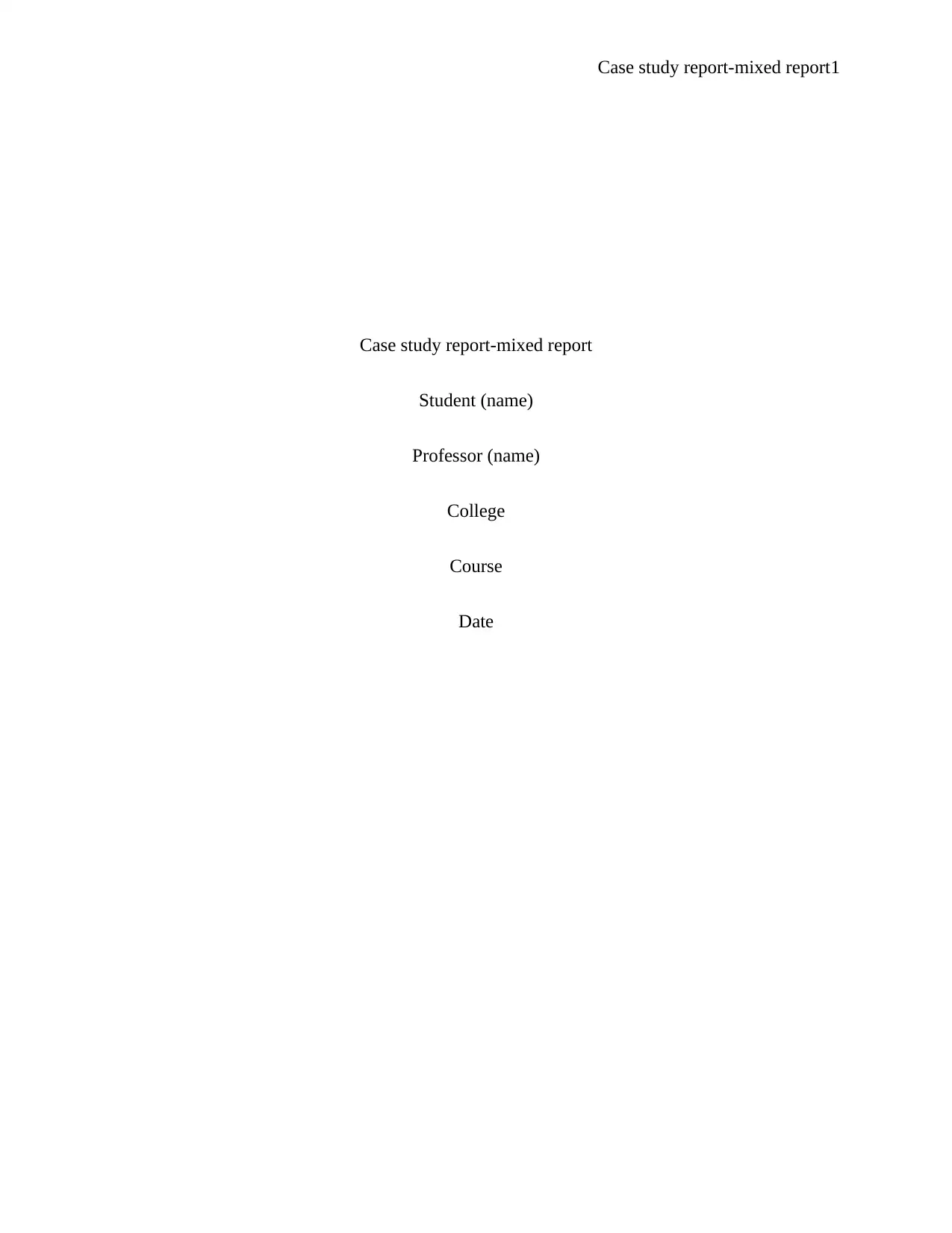
Case study report-mixed report1
Case study report-mixed report
Student (name)
Professor (name)
College
Course
Date
Case study report-mixed report
Student (name)
Professor (name)
College
Course
Date
Paraphrase This Document
Need a fresh take? Get an instant paraphrase of this document with our AI Paraphraser
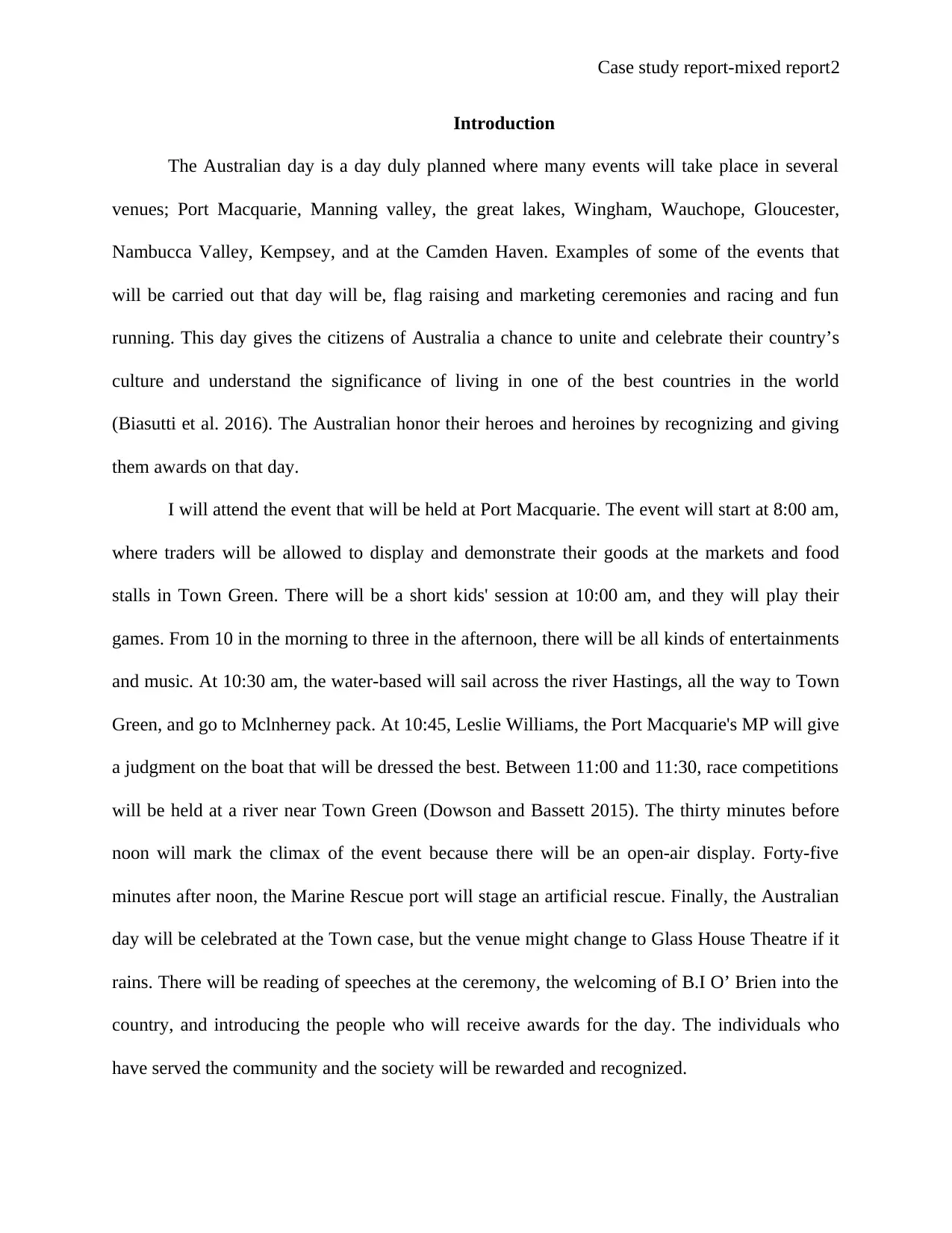
Case study report-mixed report2
Introduction
The Australian day is a day duly planned where many events will take place in several
venues; Port Macquarie, Manning valley, the great lakes, Wingham, Wauchope, Gloucester,
Nambucca Valley, Kempsey, and at the Camden Haven. Examples of some of the events that
will be carried out that day will be, flag raising and marketing ceremonies and racing and fun
running. This day gives the citizens of Australia a chance to unite and celebrate their country’s
culture and understand the significance of living in one of the best countries in the world
(Biasutti et al. 2016). The Australian honor their heroes and heroines by recognizing and giving
them awards on that day.
I will attend the event that will be held at Port Macquarie. The event will start at 8:00 am,
where traders will be allowed to display and demonstrate their goods at the markets and food
stalls in Town Green. There will be a short kids' session at 10:00 am, and they will play their
games. From 10 in the morning to three in the afternoon, there will be all kinds of entertainments
and music. At 10:30 am, the water-based will sail across the river Hastings, all the way to Town
Green, and go to Mclnherney pack. At 10:45, Leslie Williams, the Port Macquarie's MP will give
a judgment on the boat that will be dressed the best. Between 11:00 and 11:30, race competitions
will be held at a river near Town Green (Dowson and Bassett 2015). The thirty minutes before
noon will mark the climax of the event because there will be an open-air display. Forty-five
minutes after noon, the Marine Rescue port will stage an artificial rescue. Finally, the Australian
day will be celebrated at the Town case, but the venue might change to Glass House Theatre if it
rains. There will be reading of speeches at the ceremony, the welcoming of B.I O’ Brien into the
country, and introducing the people who will receive awards for the day. The individuals who
have served the community and the society will be rewarded and recognized.
Introduction
The Australian day is a day duly planned where many events will take place in several
venues; Port Macquarie, Manning valley, the great lakes, Wingham, Wauchope, Gloucester,
Nambucca Valley, Kempsey, and at the Camden Haven. Examples of some of the events that
will be carried out that day will be, flag raising and marketing ceremonies and racing and fun
running. This day gives the citizens of Australia a chance to unite and celebrate their country’s
culture and understand the significance of living in one of the best countries in the world
(Biasutti et al. 2016). The Australian honor their heroes and heroines by recognizing and giving
them awards on that day.
I will attend the event that will be held at Port Macquarie. The event will start at 8:00 am,
where traders will be allowed to display and demonstrate their goods at the markets and food
stalls in Town Green. There will be a short kids' session at 10:00 am, and they will play their
games. From 10 in the morning to three in the afternoon, there will be all kinds of entertainments
and music. At 10:30 am, the water-based will sail across the river Hastings, all the way to Town
Green, and go to Mclnherney pack. At 10:45, Leslie Williams, the Port Macquarie's MP will give
a judgment on the boat that will be dressed the best. Between 11:00 and 11:30, race competitions
will be held at a river near Town Green (Dowson and Bassett 2015). The thirty minutes before
noon will mark the climax of the event because there will be an open-air display. Forty-five
minutes after noon, the Marine Rescue port will stage an artificial rescue. Finally, the Australian
day will be celebrated at the Town case, but the venue might change to Glass House Theatre if it
rains. There will be reading of speeches at the ceremony, the welcoming of B.I O’ Brien into the
country, and introducing the people who will receive awards for the day. The individuals who
have served the community and the society will be rewarded and recognized.
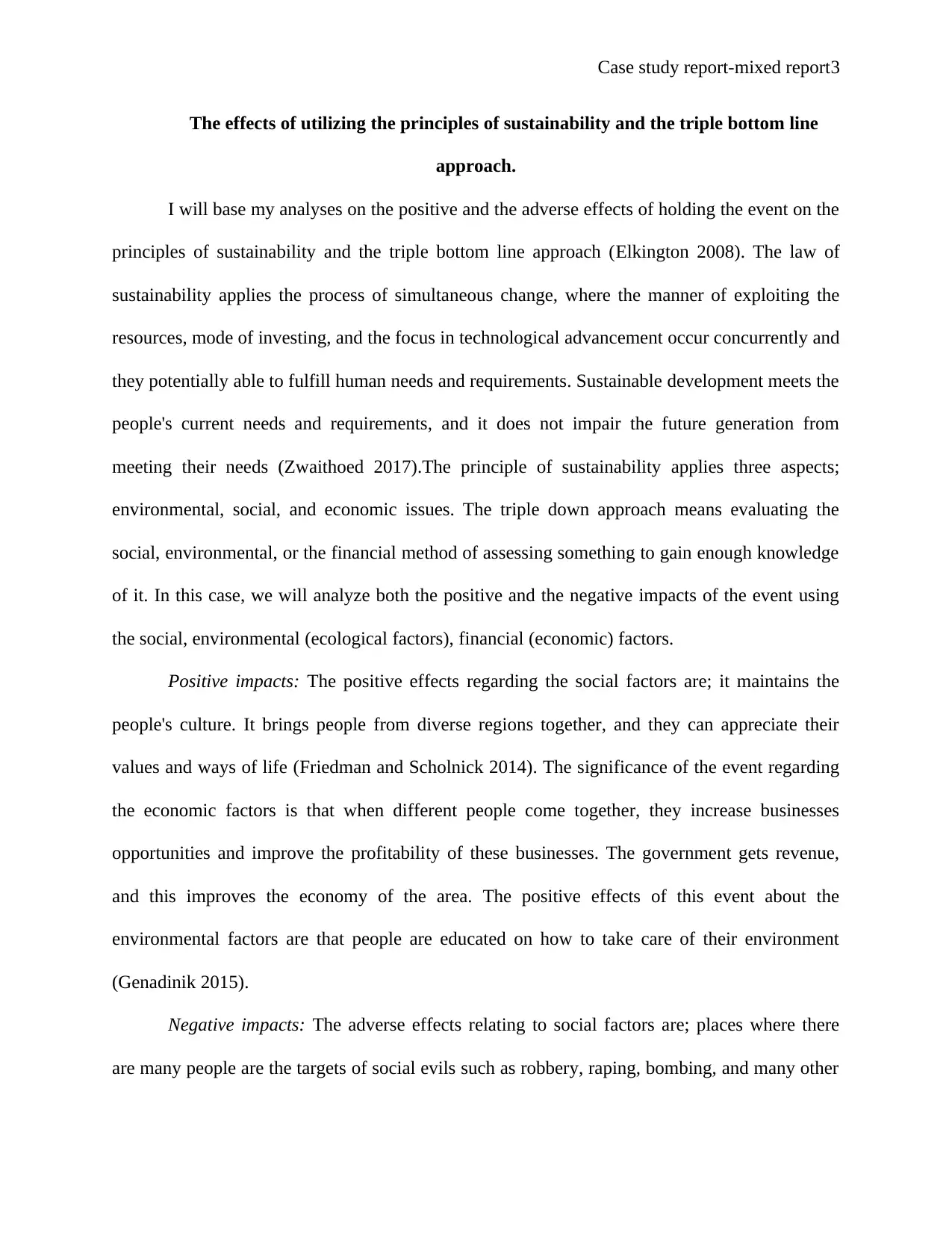
Case study report-mixed report3
The effects of utilizing the principles of sustainability and the triple bottom line
approach.
I will base my analyses on the positive and the adverse effects of holding the event on the
principles of sustainability and the triple bottom line approach (Elkington 2008). The law of
sustainability applies the process of simultaneous change, where the manner of exploiting the
resources, mode of investing, and the focus in technological advancement occur concurrently and
they potentially able to fulfill human needs and requirements. Sustainable development meets the
people's current needs and requirements, and it does not impair the future generation from
meeting their needs (Zwaithoed 2017).The principle of sustainability applies three aspects;
environmental, social, and economic issues. The triple down approach means evaluating the
social, environmental, or the financial method of assessing something to gain enough knowledge
of it. In this case, we will analyze both the positive and the negative impacts of the event using
the social, environmental (ecological factors), financial (economic) factors.
Positive impacts: The positive effects regarding the social factors are; it maintains the
people's culture. It brings people from diverse regions together, and they can appreciate their
values and ways of life (Friedman and Scholnick 2014). The significance of the event regarding
the economic factors is that when different people come together, they increase businesses
opportunities and improve the profitability of these businesses. The government gets revenue,
and this improves the economy of the area. The positive effects of this event about the
environmental factors are that people are educated on how to take care of their environment
(Genadinik 2015).
Negative impacts: The adverse effects relating to social factors are; places where there
are many people are the targets of social evils such as robbery, raping, bombing, and many other
The effects of utilizing the principles of sustainability and the triple bottom line
approach.
I will base my analyses on the positive and the adverse effects of holding the event on the
principles of sustainability and the triple bottom line approach (Elkington 2008). The law of
sustainability applies the process of simultaneous change, where the manner of exploiting the
resources, mode of investing, and the focus in technological advancement occur concurrently and
they potentially able to fulfill human needs and requirements. Sustainable development meets the
people's current needs and requirements, and it does not impair the future generation from
meeting their needs (Zwaithoed 2017).The principle of sustainability applies three aspects;
environmental, social, and economic issues. The triple down approach means evaluating the
social, environmental, or the financial method of assessing something to gain enough knowledge
of it. In this case, we will analyze both the positive and the negative impacts of the event using
the social, environmental (ecological factors), financial (economic) factors.
Positive impacts: The positive effects regarding the social factors are; it maintains the
people's culture. It brings people from diverse regions together, and they can appreciate their
values and ways of life (Friedman and Scholnick 2014). The significance of the event regarding
the economic factors is that when different people come together, they increase businesses
opportunities and improve the profitability of these businesses. The government gets revenue,
and this improves the economy of the area. The positive effects of this event about the
environmental factors are that people are educated on how to take care of their environment
(Genadinik 2015).
Negative impacts: The adverse effects relating to social factors are; places where there
are many people are the targets of social evils such as robbery, raping, bombing, and many other
⊘ This is a preview!⊘
Do you want full access?
Subscribe today to unlock all pages.

Trusted by 1+ million students worldwide
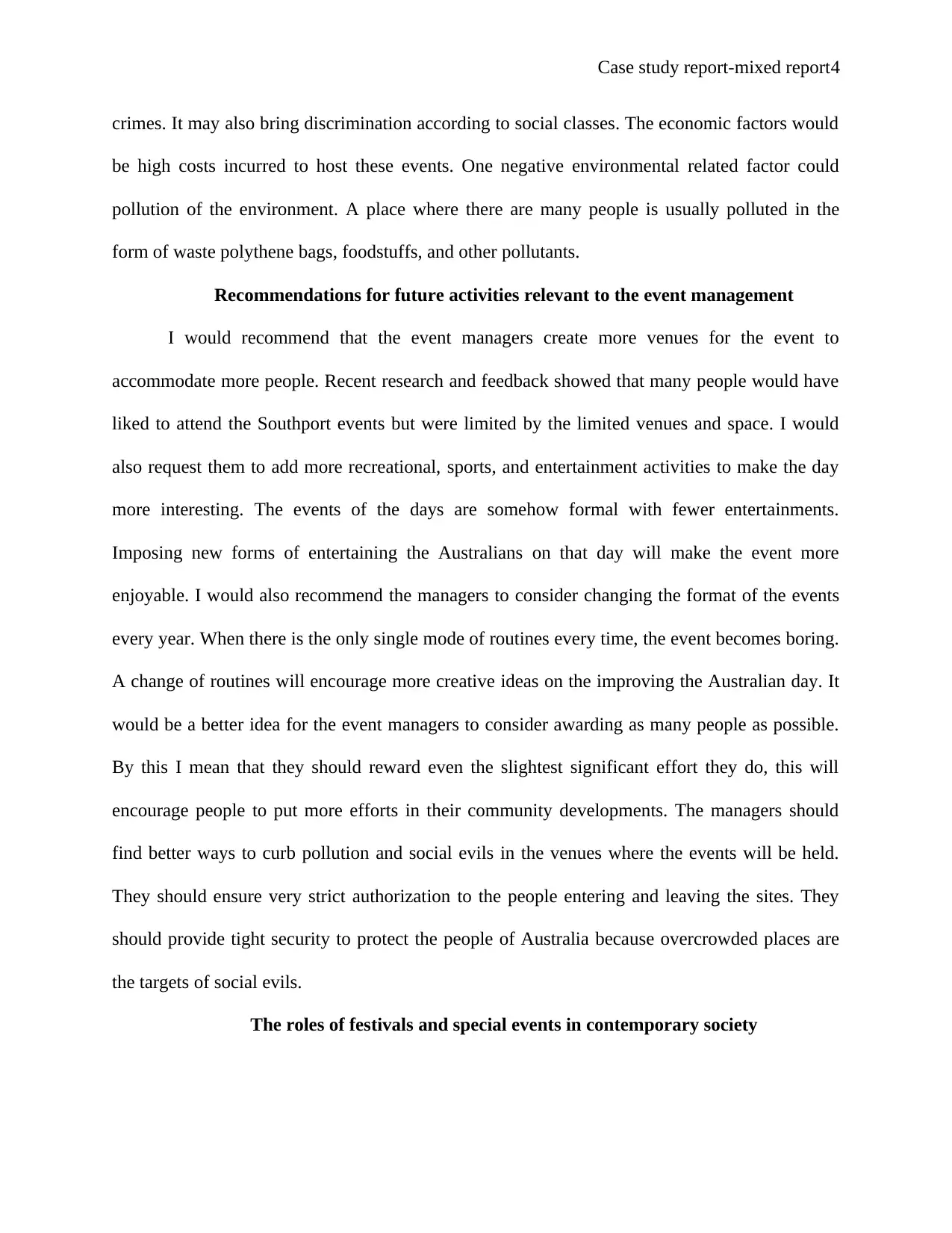
Case study report-mixed report4
crimes. It may also bring discrimination according to social classes. The economic factors would
be high costs incurred to host these events. One negative environmental related factor could
pollution of the environment. A place where there are many people is usually polluted in the
form of waste polythene bags, foodstuffs, and other pollutants.
Recommendations for future activities relevant to the event management
I would recommend that the event managers create more venues for the event to
accommodate more people. Recent research and feedback showed that many people would have
liked to attend the Southport events but were limited by the limited venues and space. I would
also request them to add more recreational, sports, and entertainment activities to make the day
more interesting. The events of the days are somehow formal with fewer entertainments.
Imposing new forms of entertaining the Australians on that day will make the event more
enjoyable. I would also recommend the managers to consider changing the format of the events
every year. When there is the only single mode of routines every time, the event becomes boring.
A change of routines will encourage more creative ideas on the improving the Australian day. It
would be a better idea for the event managers to consider awarding as many people as possible.
By this I mean that they should reward even the slightest significant effort they do, this will
encourage people to put more efforts in their community developments. The managers should
find better ways to curb pollution and social evils in the venues where the events will be held.
They should ensure very strict authorization to the people entering and leaving the sites. They
should provide tight security to protect the people of Australia because overcrowded places are
the targets of social evils.
The roles of festivals and special events in contemporary society
crimes. It may also bring discrimination according to social classes. The economic factors would
be high costs incurred to host these events. One negative environmental related factor could
pollution of the environment. A place where there are many people is usually polluted in the
form of waste polythene bags, foodstuffs, and other pollutants.
Recommendations for future activities relevant to the event management
I would recommend that the event managers create more venues for the event to
accommodate more people. Recent research and feedback showed that many people would have
liked to attend the Southport events but were limited by the limited venues and space. I would
also request them to add more recreational, sports, and entertainment activities to make the day
more interesting. The events of the days are somehow formal with fewer entertainments.
Imposing new forms of entertaining the Australians on that day will make the event more
enjoyable. I would also recommend the managers to consider changing the format of the events
every year. When there is the only single mode of routines every time, the event becomes boring.
A change of routines will encourage more creative ideas on the improving the Australian day. It
would be a better idea for the event managers to consider awarding as many people as possible.
By this I mean that they should reward even the slightest significant effort they do, this will
encourage people to put more efforts in their community developments. The managers should
find better ways to curb pollution and social evils in the venues where the events will be held.
They should ensure very strict authorization to the people entering and leaving the sites. They
should provide tight security to protect the people of Australia because overcrowded places are
the targets of social evils.
The roles of festivals and special events in contemporary society
Paraphrase This Document
Need a fresh take? Get an instant paraphrase of this document with our AI Paraphraser
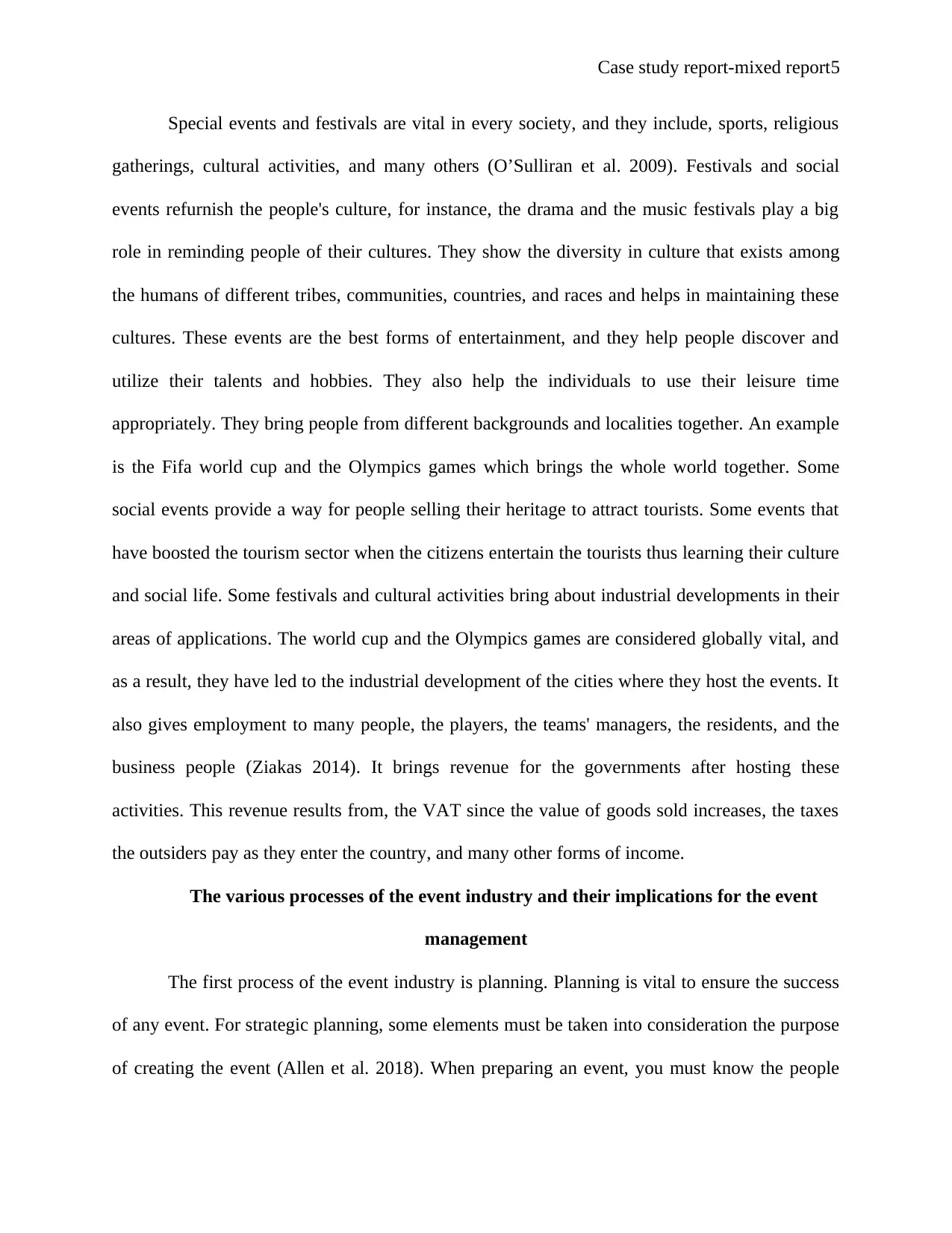
Case study report-mixed report5
Special events and festivals are vital in every society, and they include, sports, religious
gatherings, cultural activities, and many others (O’Sulliran et al. 2009). Festivals and social
events refurnish the people's culture, for instance, the drama and the music festivals play a big
role in reminding people of their cultures. They show the diversity in culture that exists among
the humans of different tribes, communities, countries, and races and helps in maintaining these
cultures. These events are the best forms of entertainment, and they help people discover and
utilize their talents and hobbies. They also help the individuals to use their leisure time
appropriately. They bring people from different backgrounds and localities together. An example
is the Fifa world cup and the Olympics games which brings the whole world together. Some
social events provide a way for people selling their heritage to attract tourists. Some events that
have boosted the tourism sector when the citizens entertain the tourists thus learning their culture
and social life. Some festivals and cultural activities bring about industrial developments in their
areas of applications. The world cup and the Olympics games are considered globally vital, and
as a result, they have led to the industrial development of the cities where they host the events. It
also gives employment to many people, the players, the teams' managers, the residents, and the
business people (Ziakas 2014). It brings revenue for the governments after hosting these
activities. This revenue results from, the VAT since the value of goods sold increases, the taxes
the outsiders pay as they enter the country, and many other forms of income.
The various processes of the event industry and their implications for the event
management
The first process of the event industry is planning. Planning is vital to ensure the success
of any event. For strategic planning, some elements must be taken into consideration the purpose
of creating the event (Allen et al. 2018). When preparing an event, you must know the people
Special events and festivals are vital in every society, and they include, sports, religious
gatherings, cultural activities, and many others (O’Sulliran et al. 2009). Festivals and social
events refurnish the people's culture, for instance, the drama and the music festivals play a big
role in reminding people of their cultures. They show the diversity in culture that exists among
the humans of different tribes, communities, countries, and races and helps in maintaining these
cultures. These events are the best forms of entertainment, and they help people discover and
utilize their talents and hobbies. They also help the individuals to use their leisure time
appropriately. They bring people from different backgrounds and localities together. An example
is the Fifa world cup and the Olympics games which brings the whole world together. Some
social events provide a way for people selling their heritage to attract tourists. Some events that
have boosted the tourism sector when the citizens entertain the tourists thus learning their culture
and social life. Some festivals and cultural activities bring about industrial developments in their
areas of applications. The world cup and the Olympics games are considered globally vital, and
as a result, they have led to the industrial development of the cities where they host the events. It
also gives employment to many people, the players, the teams' managers, the residents, and the
business people (Ziakas 2014). It brings revenue for the governments after hosting these
activities. This revenue results from, the VAT since the value of goods sold increases, the taxes
the outsiders pay as they enter the country, and many other forms of income.
The various processes of the event industry and their implications for the event
management
The first process of the event industry is planning. Planning is vital to ensure the success
of any event. For strategic planning, some elements must be taken into consideration the purpose
of creating the event (Allen et al. 2018). When preparing an event, you must know the people
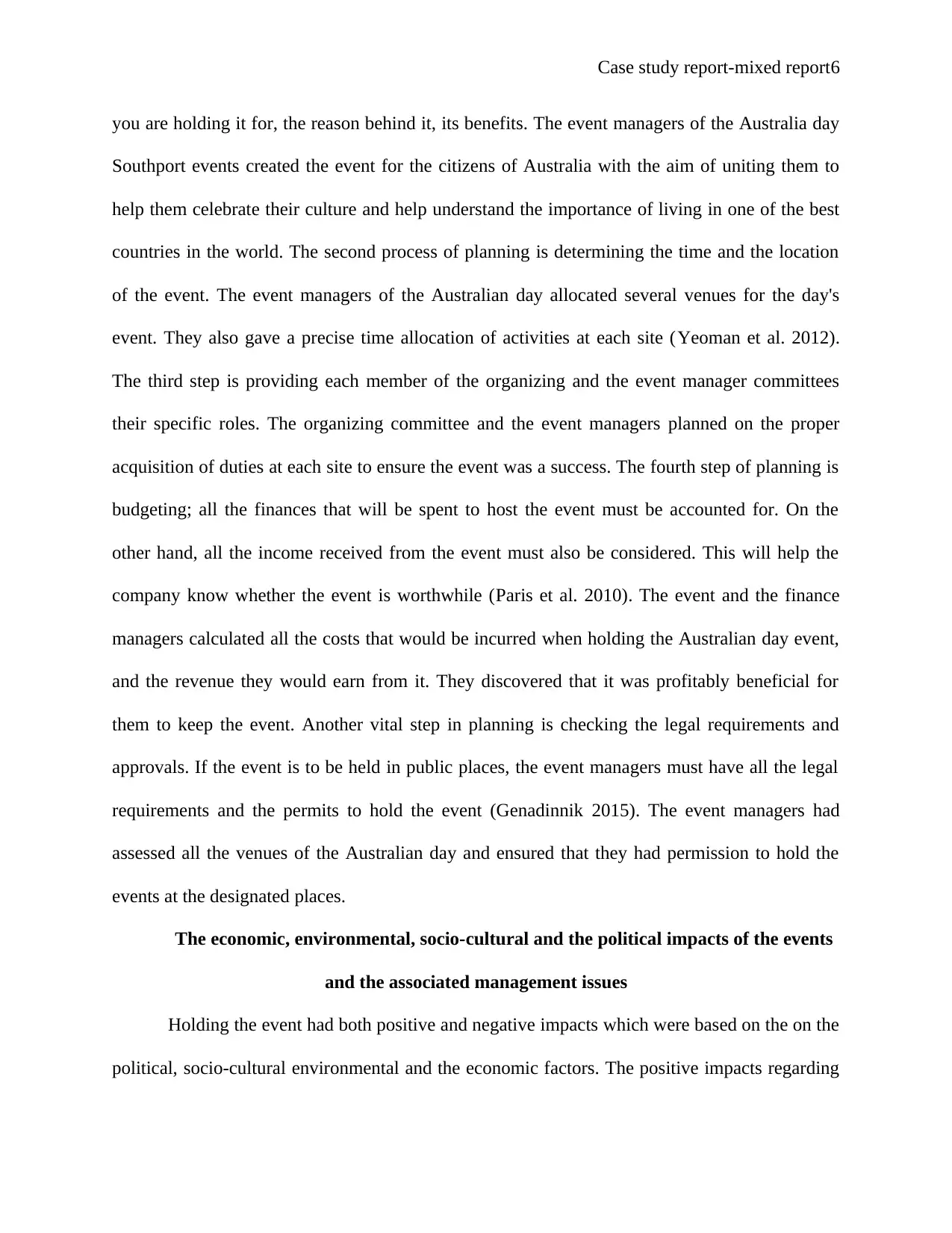
Case study report-mixed report6
you are holding it for, the reason behind it, its benefits. The event managers of the Australia day
Southport events created the event for the citizens of Australia with the aim of uniting them to
help them celebrate their culture and help understand the importance of living in one of the best
countries in the world. The second process of planning is determining the time and the location
of the event. The event managers of the Australian day allocated several venues for the day's
event. They also gave a precise time allocation of activities at each site (Yeoman et al. 2012).
The third step is providing each member of the organizing and the event manager committees
their specific roles. The organizing committee and the event managers planned on the proper
acquisition of duties at each site to ensure the event was a success. The fourth step of planning is
budgeting; all the finances that will be spent to host the event must be accounted for. On the
other hand, all the income received from the event must also be considered. This will help the
company know whether the event is worthwhile (Paris et al. 2010). The event and the finance
managers calculated all the costs that would be incurred when holding the Australian day event,
and the revenue they would earn from it. They discovered that it was profitably beneficial for
them to keep the event. Another vital step in planning is checking the legal requirements and
approvals. If the event is to be held in public places, the event managers must have all the legal
requirements and the permits to hold the event (Genadinnik 2015). The event managers had
assessed all the venues of the Australian day and ensured that they had permission to hold the
events at the designated places.
The economic, environmental, socio-cultural and the political impacts of the events
and the associated management issues
Holding the event had both positive and negative impacts which were based on the on the
political, socio-cultural environmental and the economic factors. The positive impacts regarding
you are holding it for, the reason behind it, its benefits. The event managers of the Australia day
Southport events created the event for the citizens of Australia with the aim of uniting them to
help them celebrate their culture and help understand the importance of living in one of the best
countries in the world. The second process of planning is determining the time and the location
of the event. The event managers of the Australian day allocated several venues for the day's
event. They also gave a precise time allocation of activities at each site (Yeoman et al. 2012).
The third step is providing each member of the organizing and the event manager committees
their specific roles. The organizing committee and the event managers planned on the proper
acquisition of duties at each site to ensure the event was a success. The fourth step of planning is
budgeting; all the finances that will be spent to host the event must be accounted for. On the
other hand, all the income received from the event must also be considered. This will help the
company know whether the event is worthwhile (Paris et al. 2010). The event and the finance
managers calculated all the costs that would be incurred when holding the Australian day event,
and the revenue they would earn from it. They discovered that it was profitably beneficial for
them to keep the event. Another vital step in planning is checking the legal requirements and
approvals. If the event is to be held in public places, the event managers must have all the legal
requirements and the permits to hold the event (Genadinnik 2015). The event managers had
assessed all the venues of the Australian day and ensured that they had permission to hold the
events at the designated places.
The economic, environmental, socio-cultural and the political impacts of the events
and the associated management issues
Holding the event had both positive and negative impacts which were based on the on the
political, socio-cultural environmental and the economic factors. The positive impacts regarding
⊘ This is a preview!⊘
Do you want full access?
Subscribe today to unlock all pages.

Trusted by 1+ million students worldwide
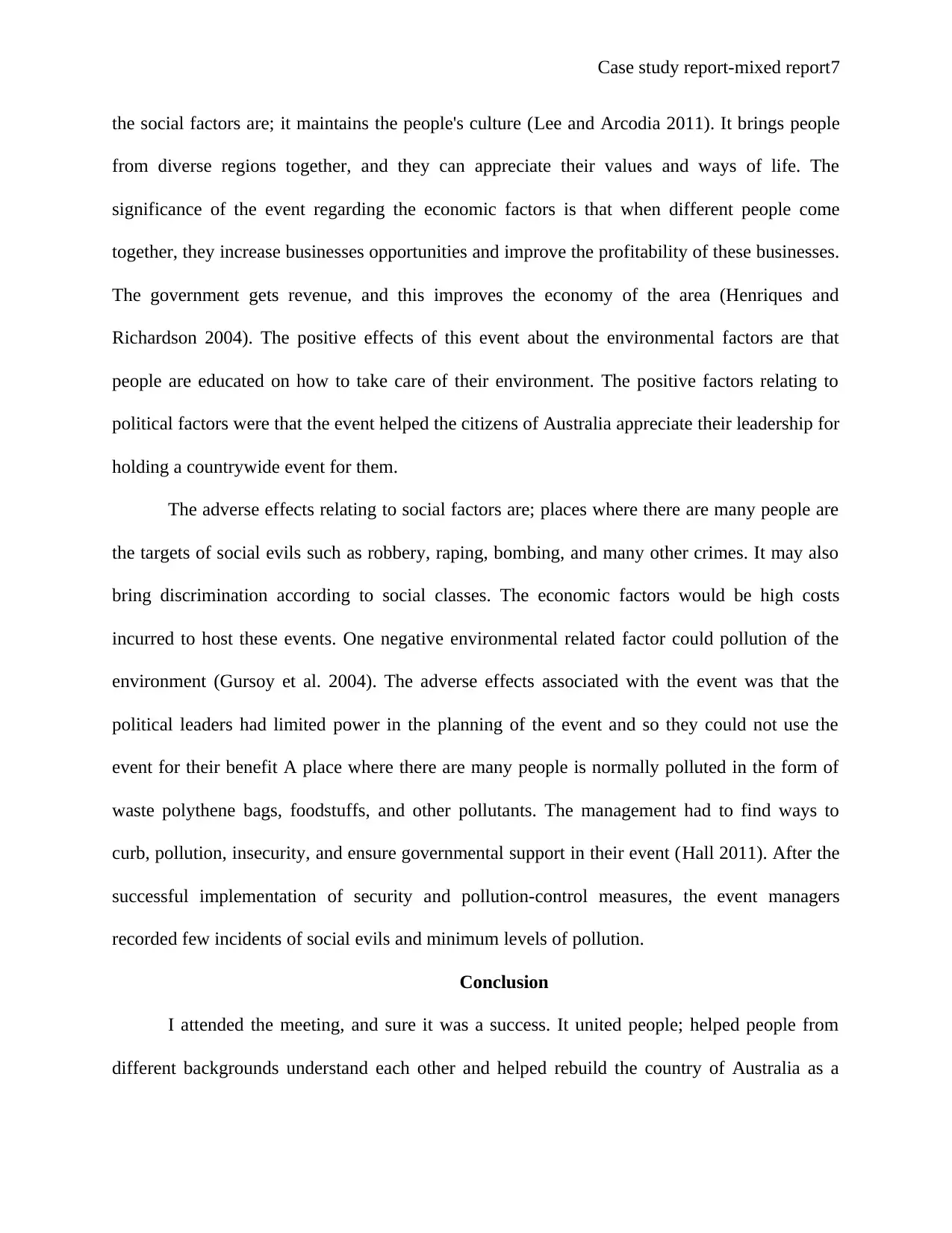
Case study report-mixed report7
the social factors are; it maintains the people's culture (Lee and Arcodia 2011). It brings people
from diverse regions together, and they can appreciate their values and ways of life. The
significance of the event regarding the economic factors is that when different people come
together, they increase businesses opportunities and improve the profitability of these businesses.
The government gets revenue, and this improves the economy of the area (Henriques and
Richardson 2004). The positive effects of this event about the environmental factors are that
people are educated on how to take care of their environment. The positive factors relating to
political factors were that the event helped the citizens of Australia appreciate their leadership for
holding a countrywide event for them.
The adverse effects relating to social factors are; places where there are many people are
the targets of social evils such as robbery, raping, bombing, and many other crimes. It may also
bring discrimination according to social classes. The economic factors would be high costs
incurred to host these events. One negative environmental related factor could pollution of the
environment (Gursoy et al. 2004). The adverse effects associated with the event was that the
political leaders had limited power in the planning of the event and so they could not use the
event for their benefit A place where there are many people is normally polluted in the form of
waste polythene bags, foodstuffs, and other pollutants. The management had to find ways to
curb, pollution, insecurity, and ensure governmental support in their event (Hall 2011). After the
successful implementation of security and pollution-control measures, the event managers
recorded few incidents of social evils and minimum levels of pollution.
Conclusion
I attended the meeting, and sure it was a success. It united people; helped people from
different backgrounds understand each other and helped rebuild the country of Australia as a
the social factors are; it maintains the people's culture (Lee and Arcodia 2011). It brings people
from diverse regions together, and they can appreciate their values and ways of life. The
significance of the event regarding the economic factors is that when different people come
together, they increase businesses opportunities and improve the profitability of these businesses.
The government gets revenue, and this improves the economy of the area (Henriques and
Richardson 2004). The positive effects of this event about the environmental factors are that
people are educated on how to take care of their environment. The positive factors relating to
political factors were that the event helped the citizens of Australia appreciate their leadership for
holding a countrywide event for them.
The adverse effects relating to social factors are; places where there are many people are
the targets of social evils such as robbery, raping, bombing, and many other crimes. It may also
bring discrimination according to social classes. The economic factors would be high costs
incurred to host these events. One negative environmental related factor could pollution of the
environment (Gursoy et al. 2004). The adverse effects associated with the event was that the
political leaders had limited power in the planning of the event and so they could not use the
event for their benefit A place where there are many people is normally polluted in the form of
waste polythene bags, foodstuffs, and other pollutants. The management had to find ways to
curb, pollution, insecurity, and ensure governmental support in their event (Hall 2011). After the
successful implementation of security and pollution-control measures, the event managers
recorded few incidents of social evils and minimum levels of pollution.
Conclusion
I attended the meeting, and sure it was a success. It united people; helped people from
different backgrounds understand each other and helped rebuild the country of Australia as a
Paraphrase This Document
Need a fresh take? Get an instant paraphrase of this document with our AI Paraphraser
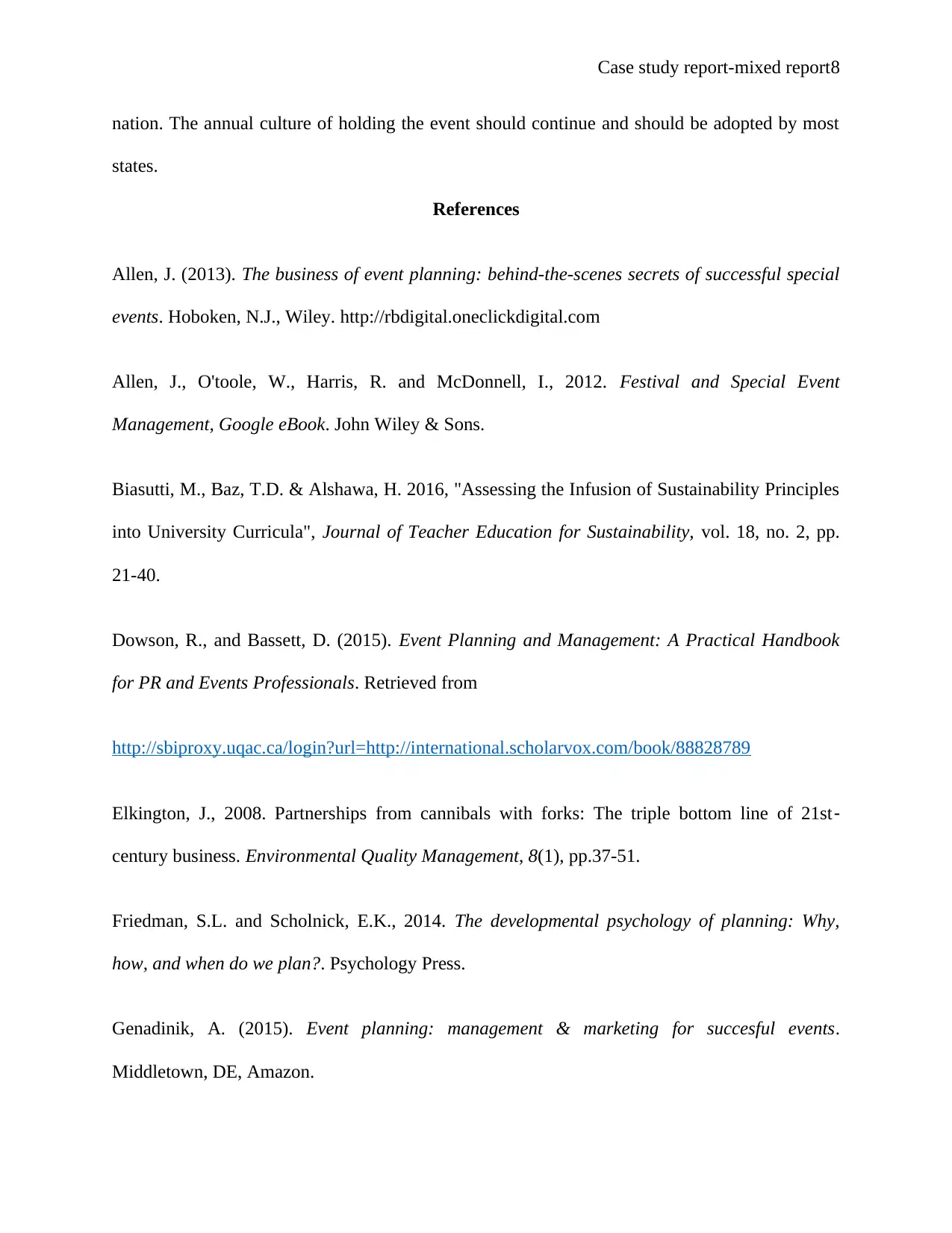
Case study report-mixed report8
nation. The annual culture of holding the event should continue and should be adopted by most
states.
References
Allen, J. (2013). The business of event planning: behind-the-scenes secrets of successful special
events. Hoboken, N.J., Wiley. http://rbdigital.oneclickdigital.com
Allen, J., O'toole, W., Harris, R. and McDonnell, I., 2012. Festival and Special Event
Management, Google eBook. John Wiley & Sons.
Biasutti, M., Baz, T.D. & Alshawa, H. 2016, "Assessing the Infusion of Sustainability Principles
into University Curricula", Journal of Teacher Education for Sustainability, vol. 18, no. 2, pp.
21-40.
Dowson, R., and Bassett, D. (2015). Event Planning and Management: A Practical Handbook
for PR and Events Professionals. Retrieved from
http://sbiproxy.uqac.ca/login?url=http://international.scholarvox.com/book/88828789
Elkington, J., 2008. Partnerships from cannibals with forks: The triple bottom line of 21st‐
century business. Environmental Quality Management, 8(1), pp.37-51.
Friedman, S.L. and Scholnick, E.K., 2014. The developmental psychology of planning: Why,
how, and when do we plan?. Psychology Press.
Genadinik, A. (2015). Event planning: management & marketing for succesful events.
Middletown, DE, Amazon.
nation. The annual culture of holding the event should continue and should be adopted by most
states.
References
Allen, J. (2013). The business of event planning: behind-the-scenes secrets of successful special
events. Hoboken, N.J., Wiley. http://rbdigital.oneclickdigital.com
Allen, J., O'toole, W., Harris, R. and McDonnell, I., 2012. Festival and Special Event
Management, Google eBook. John Wiley & Sons.
Biasutti, M., Baz, T.D. & Alshawa, H. 2016, "Assessing the Infusion of Sustainability Principles
into University Curricula", Journal of Teacher Education for Sustainability, vol. 18, no. 2, pp.
21-40.
Dowson, R., and Bassett, D. (2015). Event Planning and Management: A Practical Handbook
for PR and Events Professionals. Retrieved from
http://sbiproxy.uqac.ca/login?url=http://international.scholarvox.com/book/88828789
Elkington, J., 2008. Partnerships from cannibals with forks: The triple bottom line of 21st‐
century business. Environmental Quality Management, 8(1), pp.37-51.
Friedman, S.L. and Scholnick, E.K., 2014. The developmental psychology of planning: Why,
how, and when do we plan?. Psychology Press.
Genadinik, A. (2015). Event planning: management & marketing for succesful events.
Middletown, DE, Amazon.
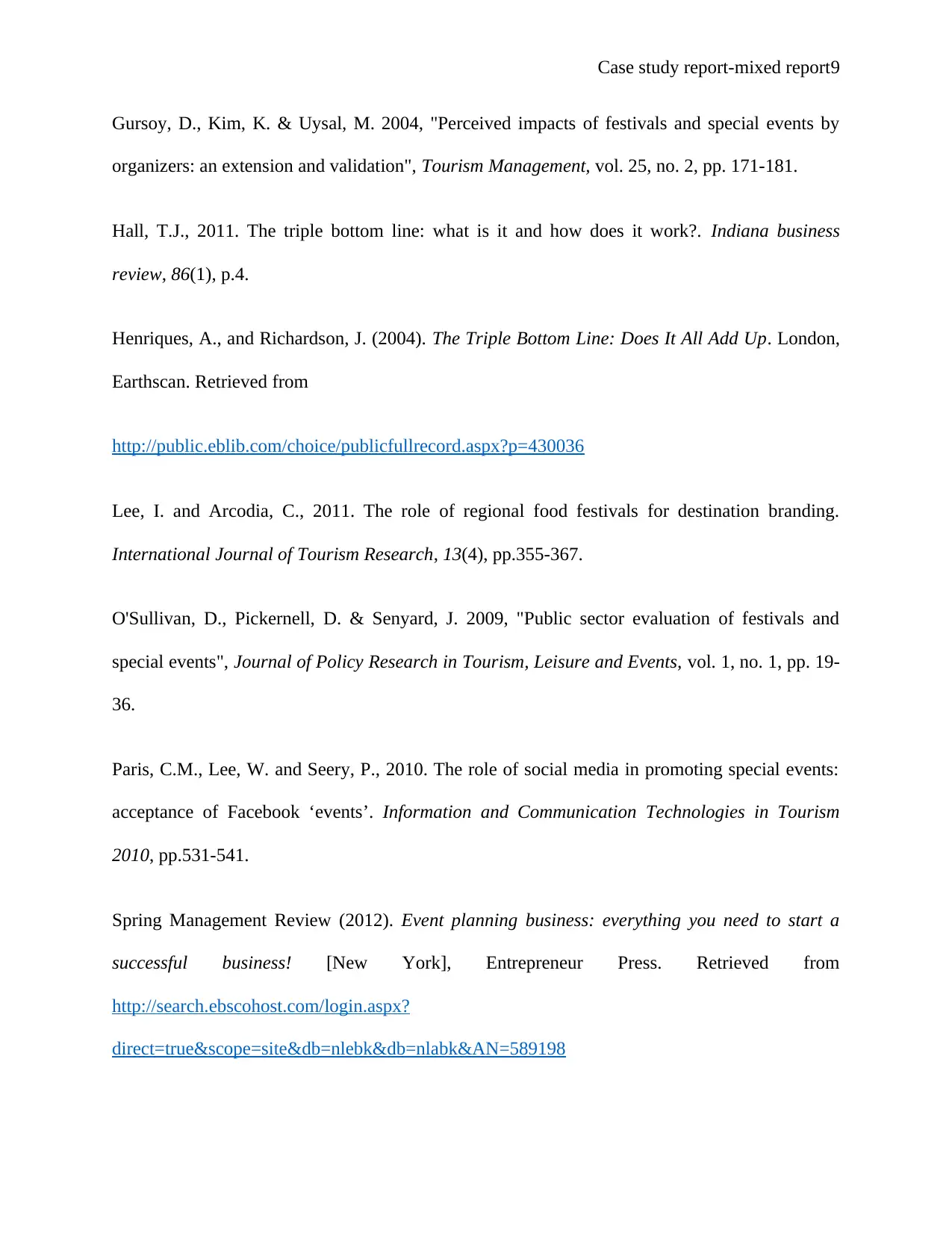
Case study report-mixed report9
Gursoy, D., Kim, K. & Uysal, M. 2004, "Perceived impacts of festivals and special events by
organizers: an extension and validation", Tourism Management, vol. 25, no. 2, pp. 171-181.
Hall, T.J., 2011. The triple bottom line: what is it and how does it work?. Indiana business
review, 86(1), p.4.
Henriques, A., and Richardson, J. (2004). The Triple Bottom Line: Does It All Add Up. London,
Earthscan. Retrieved from
http://public.eblib.com/choice/publicfullrecord.aspx?p=430036
Lee, I. and Arcodia, C., 2011. The role of regional food festivals for destination branding.
International Journal of Tourism Research, 13(4), pp.355-367.
O'Sullivan, D., Pickernell, D. & Senyard, J. 2009, "Public sector evaluation of festivals and
special events", Journal of Policy Research in Tourism, Leisure and Events, vol. 1, no. 1, pp. 19-
36.
Paris, C.M., Lee, W. and Seery, P., 2010. The role of social media in promoting special events:
acceptance of Facebook ‘events’. Information and Communication Technologies in Tourism
2010, pp.531-541.
Spring Management Review (2012). Event planning business: everything you need to start a
successful business! [New York], Entrepreneur Press. Retrieved from
http://search.ebscohost.com/login.aspx?
direct=true&scope=site&db=nlebk&db=nlabk&AN=589198
Gursoy, D., Kim, K. & Uysal, M. 2004, "Perceived impacts of festivals and special events by
organizers: an extension and validation", Tourism Management, vol. 25, no. 2, pp. 171-181.
Hall, T.J., 2011. The triple bottom line: what is it and how does it work?. Indiana business
review, 86(1), p.4.
Henriques, A., and Richardson, J. (2004). The Triple Bottom Line: Does It All Add Up. London,
Earthscan. Retrieved from
http://public.eblib.com/choice/publicfullrecord.aspx?p=430036
Lee, I. and Arcodia, C., 2011. The role of regional food festivals for destination branding.
International Journal of Tourism Research, 13(4), pp.355-367.
O'Sullivan, D., Pickernell, D. & Senyard, J. 2009, "Public sector evaluation of festivals and
special events", Journal of Policy Research in Tourism, Leisure and Events, vol. 1, no. 1, pp. 19-
36.
Paris, C.M., Lee, W. and Seery, P., 2010. The role of social media in promoting special events:
acceptance of Facebook ‘events’. Information and Communication Technologies in Tourism
2010, pp.531-541.
Spring Management Review (2012). Event planning business: everything you need to start a
successful business! [New York], Entrepreneur Press. Retrieved from
http://search.ebscohost.com/login.aspx?
direct=true&scope=site&db=nlebk&db=nlabk&AN=589198
⊘ This is a preview!⊘
Do you want full access?
Subscribe today to unlock all pages.

Trusted by 1+ million students worldwide
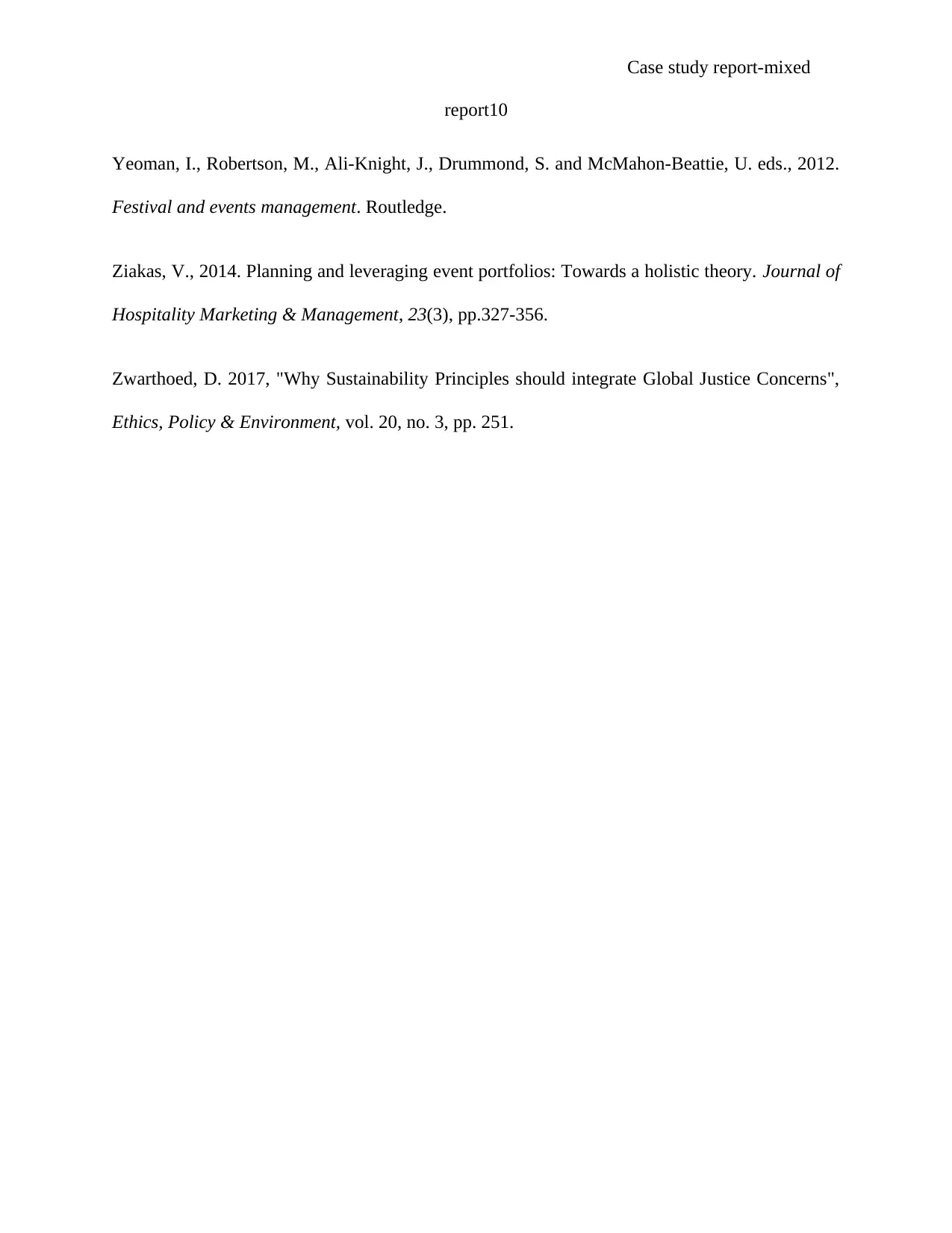
Case study report-mixed
report10
Yeoman, I., Robertson, M., Ali-Knight, J., Drummond, S. and McMahon-Beattie, U. eds., 2012.
Festival and events management. Routledge.
Ziakas, V., 2014. Planning and leveraging event portfolios: Towards a holistic theory. Journal of
Hospitality Marketing & Management, 23(3), pp.327-356.
Zwarthoed, D. 2017, "Why Sustainability Principles should integrate Global Justice Concerns",
Ethics, Policy & Environment, vol. 20, no. 3, pp. 251.
report10
Yeoman, I., Robertson, M., Ali-Knight, J., Drummond, S. and McMahon-Beattie, U. eds., 2012.
Festival and events management. Routledge.
Ziakas, V., 2014. Planning and leveraging event portfolios: Towards a holistic theory. Journal of
Hospitality Marketing & Management, 23(3), pp.327-356.
Zwarthoed, D. 2017, "Why Sustainability Principles should integrate Global Justice Concerns",
Ethics, Policy & Environment, vol. 20, no. 3, pp. 251.
1 out of 10
Your All-in-One AI-Powered Toolkit for Academic Success.
+13062052269
info@desklib.com
Available 24*7 on WhatsApp / Email
![[object Object]](/_next/static/media/star-bottom.7253800d.svg)
Unlock your academic potential
Copyright © 2020–2025 A2Z Services. All Rights Reserved. Developed and managed by ZUCOL.